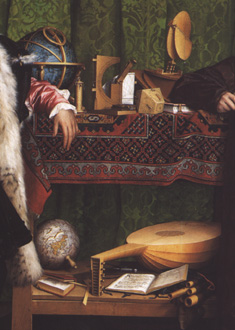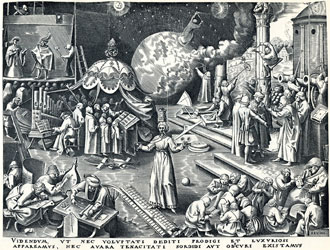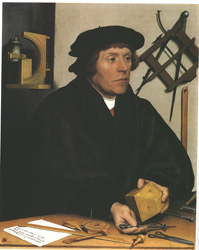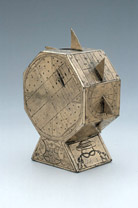


The objects displayed on the two-tiered table pertain to the new learning grounded in experience and observation and intended for practical use, instead of the authoritative texts focusing on theory associated with the traditional university curriculum inherited from the Middle Ages.* For example, the arithmetic book on the lower shelf is a merchant's guide to the practical applications of arithmetic in business. Likewise, the choice of a lute, a case of flutes, and a hymn book refers to the practice rather than the theory of music. The terrestrial globe on the lower shelf attests to the the period's keen interest in cartography. The astronomical instruments on the upper shelf pertain to the empirical study and use of astronomy. These objects can be related to the "renaissance" of instrument-making that began in Germany during the latter half of the fifteenth century.* The painting itself is a statement of the new science of perspective. The objects can be clearly associated with the Quadrivium, the four mathematical disciplines that were part of the Seven Liberal Arts: arithmetic, geometry, music, and astronomy. This is not the Quadrivium of the medieval university but of the new learning.
The contrast between the traditional learning based on the tradition of books and the new learning based on practical experience was a popular theme during this period. Leonardo da Vinci in his Notebooks frequently draws the contrast. Nicholas of Cusa also developed it. In a dialogue between an Orator schooled in the tradition of book learning and the Idiot whose wisdom is derived entirely from his own abilities and practical experiences, Cusa leads the Orator to appreciate the Idiot's wisdom. This opposition is developed in this following excerpt:
Orator: Being a layman, how are you able to come to the knowledge of your ignorance?
Idiot: Not from books, but from God's.
Orator: What books are those?
Idiot: The ones that He has written with His own finger.
Orator: Where are they found?
Idiot: Everywhere.
Orator: Even in this forum?
Idiot: Yes indeed. I have already said that wisdom cries out in the streets.....
Idiot: I shall attempt to demonstrate to you what I told you, namely that wisdom cries out in the streets, and her cry is that she dwells in the highest. In the first place I want you to describe what you see happening in the forum.
Orator: In one place I see money being counted; in another, goods being weighed. Directly across from us, oil and other things are being measured.
Idiot: These are the works of reason, by means of which men surpass the beasts. Brutes cannot number, weigh, and measure. *
(In this reference "number, weigh, and measure" Cusa is alluding to the analogy he develops elsewhere between Divine and human creativity.)
Popular images document the culture's fascination with this new learning based on the practical application of the mathematical sciences. This is illustrated by Pieter Bruegel the Elder's 1560 print of Temperance:

This new learning was characterized by an international exchange of information and it also witnessed an intermingling of different specializations. Practitioners from throughout Europe were in regular communication, and knowledge of new ideas and instruments was spread through the new invention of the printing press. There was a sharing of information between artists/draughtsmen, astronomers/astrologers, merchants, cartographers, instrument makers, Humanist, etc. Review of the career of Nicholaus Kratzer illustrates the nature of this culture:*

Kratzer was born in 1487, and attended the Universities of Cologne and Wittenberg. In January 1517, the Antwerp Humanist Peter Gilles wrote a letter of introduction for Kratzer to Erasmus, then in Louvain:
Pieter Gilles to Erasmus of Rotterdam, Antwerp, 18 January 1517
I felt it my duty to write to you, since Nicolaus Kratzer, who is an expert in astronomy, was leaving for your part of the world. He has with him several astrolabes and spheres to be sold there. He is bringing you a Greek book sent by the prior of St. Agnes....*
By the end of that year or early the next, Kratzer was in England, where he attracted the attention of Sir Thomas More and Cardinal Wolsey and entered the service of Henry VIII as Astrologer and Horloger in 1519. This parallels the network of relationships which Holbein used to gain entry to the English Court: Erasmus-More-Henry VIII. Holbein and Kratzer collaborated with others in 1527 on the decorations at Greenwich to celebrate the peace concluded by Francis I and Henry VIII. Kratzer split his time between service at court and participating in the commercial activities of the Company of German Merchants in London, who were also important patrons of Hans Holbein.
In 1528, Holbein painted the Louvre portrait of Kratzer:

The correspondence between the polyhedral and cylindrical sundials and the quadrant included in this portrait to the same objects in Holbein's Ambassadors is a good example of the type of collaboration that occurred between the different specialists. While dressed in the cap and coat of a scholar, Kratzer is represented as a maker of instruments of observation. Notably absent are the authoritative books associated with the medieval study of astronomy. The intersection of the interests of the artist and instrument maker is brought out by the accuracy of Holbein's rendering of these objects in both the Kratzer portrait and the Ambassadors. The collaboration between the two specialists is further brought out by Holbein's design for an astronomical clock made for Anthony Denny in 1544. The annotations on the design have been attributed to Kratzer.* The important role artists played in the work of astronomers like Kratzer is illustrated in the following excerpt of a letter sent by Kratzer in 1524 to Albrecht Dürer in Nuremberg:
...I must write to you because you are all followers of the Gospel in Nuremberg. May God send you grace, that you may persevere to the end, for the adversaries are strong, but God is still stronger...Dear Master Albrecht, I pray you to draw for me a model of the instrument that you saw at Herr Pirckheimer's, by which distances can be measured, and of which you spoke to me at Antwerp, or that you will ask Herr Pirckheimer to send me a description of the said instrument. Also I desire to know what you ask for copies of all your prints, and if there is anything new at Nuremberg in my craft. I hear that our Hans, the astronomer , is dead/ I wish you to write and tell me what he has left behind, and about Stabius, what has become of his instruments and his blocks. Greet in my name Herr Pirckheimer. I hope shortly to make a map of England which is a great country and was not known to Ptolemy; Herr Pirckheimer will be glad to see it. All who have written of it hitherto have only seen a small part of England, no more...I beg of you to send me the likeness of Stabius, fashioned to represent St. Kolman, and cut in wood.*
The reference to the "Gospel" and "grace" document the Lutheran leanings of both men (compare to the discussion of the Lutheran Hymnbook in the Ambassadors). In his letter written in response, Dürer informed Kratzer that Pirckheimer was seeing that a copy of the instrument was being made for Kratzer. In this letter he asks Kratzer about the progress of his projected translation of Euclid. Dürer's interest in a new translation of Euclid should be connected to his own interests. The next year Dürer would publish his own book on the art of measurement in which he presents the geometrical tools necessary for an artist. This book shows again the intersection of different interests. For example, Dürer includes as one of his exercises the techniques for making a polyhedral sundial:

Dürer's illustration of the sundial comes very close to a polyhedral dial that was made for Cardinal Wolsey apparently by Kratzer:

Humanists emphasized the importance of the mathematical disciplines in the study of the world. French Humanists in the circle of Lefèvre d'Etaples published a number of texts and commentaries on the various branches of the Quadrivium. For example, a joint publication of 1503 by Lefèvre and two of his students included commentaries on the arithmetic of Boethius by Josse Clichtove, essays on geometry, perspective, the squaring of the circle, and the cubification of the sphere by Charles de Bovelles, and Lefèvre's Astronomicon.* In the Elementa musicalia contained in his 1496 edition of Forestier's arithmetic, Lefèvre stressed the importance of the study of music in the arts curriculum and its dependence on a knowledge of mathematics.* In publishing manuals and practical guides written in the vernacular, Lefèvre and his disciples demonstrated their awareness of the utility of mathematics in the life of man, and explored mathematics as a means to obtain philosophical and theological truth.
Dinteville's interest in this new learning is suggested by the following reference in his letter of May 23, 1533 to his brother: "Pray send me a drawing of the oval compass of which you wrote; I cannot at all understand the fashion in which it is made." Like Kratzer's appeal to Dürer, Dinteville wants to see a drawing of the instrument which would more useful than a verbal description. Their shared interest in the new instruments and the appearance of Kratzer's own instruments in The Ambassadors suggests that Kratzer might have introduced Dinteville to Holbein.
